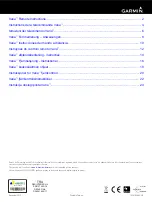
Black
1 Battery Unit
2 Battery Unit
2 Battery Unit
Red
Black
Red
Black Red
(connected in series)
(connected in parallel)
Figure 1
Figure 5
Figure 3
Figure 4
TEST
CHARGE
AC ON
WHITE - Neutral / Common
GREEN - Ground
BATTERY
NEG
-
POS
+
BATTERY -
LAMP +
LAMP -
CHARGER PC BOARD
ASSEMBLY
LAMPS
STANDARD TRI-TAP INPUT VERSION
RED - 347V Line / Hot
FUSE
CHARGER BOARD
BLACK - 120V Line / Hot
ORANGE - 277V Line / Hot
Uncoil wire and connect
end to battery terminal
Figure 2
Remove cover screws
& lift out cover
Test Switch &
LED Indicators
Cover
screw
Heads/Lamps
MAINTENANCE
Code requires that the equipment be tested every 30 days for 30 seconds, and that written records be maintained.
Further, the equipment is to be tested once a year for the required duration as per Code. The battery is to be
replaced or the equipment repaired whenever the equipment fails to operate as intended during the duration test.
Written records of test results and any repairs made must be maintained. Beluce Canada Inc. strongly recommends
compliance with all Code requirements.
1. The lamps listed herein when used according to the instructions with this unit are in accordance with the requirements
of CSA Standard C22.2, No. 141 – Unit Equipment for Emergency Lighting.
2. Clean lenses on a regular basis.
NOTE: The servicing of any parts should be performed by qualified service personnel only. The use of replacement
parts not furnished by Beluce Canada Inc., may cause equipment failure and will void the warranty.
TROUBLE SHOOTING
EMERGENCY LAMPS DO NOT COME ON AT ALL
Pilot Light is out before test...
1. Check AC supply - be sure unit has 24 hour AC supply (unswitched).
2. AC supply is OK, and indicator light is out, replace PC Board Assembly.
Pilot Light is on before test...
3. Either the output is shorted or overloaded, or the battery is not connected.
4. Battery is severely discharged. Allow 24 hours for recharge and then retest. NOTE: This could be the result of a
switched AC supply to the unit (which has been turned off at some point), a battery with a shorted cell, an old
battery or a battery which has been discharged due to a long power outage and is not yet fully recharged.
EMERGENCY LAMPS COME ON DIM WHEN TEST BUTTON IS PRESSED
1 . Battery discharged - permit unit to charge for 24 hours and then retest. If lamps are still dim, check charger for
proper function. If charger functions correctly, replace battery.
EMERGENCY LAMPS COME ON WHEN BATTERY IS FIRST CONNECTED
1 . Battery may be connected in reverse polarity. Check connections. Connect Positive lead to Positive battery
terminal and Negative lead to Negative battery terminal. The lamps should then turn off and the charge indicator
should light when AC power is applied.
EMERGENCY LAMPS COME ON DIM WHEN AC POWER IS ON -
1 . Check supply voltage and AC connections. This emergency light is provided with brownout protection.
The AC supply must be at least 80% of nominal (96V on a 120V line) for equipment to function normally.
At lower voltages the emergency lamps will begin to glow dimly until the source voltage drops below the full
“turn-on” point. NOTE: This condition may also be caused by incorrectly connecting a 120 Volt supply line to
the incorrect voltage transformer lead.
SAVE THESE INSTRUCTIONS
926000108
(-)
(+)
3 Battery Unit
connected in parallel
Red
BAT1
BAT2
BAT3
Red
Red
Black
Black
Black
(-)
(+)
(-)
(+)
To BAT1
CHARGER BOARD
To BAT2
CHARGER BOARD
Config #1
Battery terminal configuration
on charger board
Config #1
BAT1
BAT2
Config #2
BAT
Beluce Canada Inc., 3900 14th Avenue, Markham, ON L3R 4R3 Tel: (905) 948-9500 Fax: (905) 948-8673
04/09/2019




















